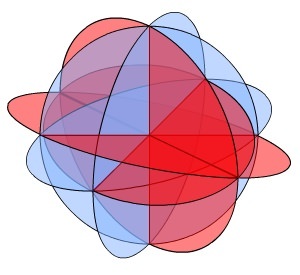10.13 摘要:系统和矩阵
Section outline
-
A system of equations is a collection of two or more equations with multiple unknown variables. We solve a system of equations by finding the values for the variables that satisfy all the equations in the system. Graphically, the solution to a system of equations is the point(s) of intersection between the lines, curves, or planes represented by the equations. In this chapter, we learned that a matrix is a rectangular array of numbers that corresponds to the coefficients in a system. Using matrices to represent systems is incredibly powerful because it makes it easier to solve for the variables. We also reviewed techniques for solving systems in two and three dimensions, developed an understanding for the concept of matrices, practiced applying a variety of properties of matrices, and used matrices to solve systems.
::系统方程式是一个由多个未知变量组成的两个或多个方程式的集合。 我们通过找到满足系统中所有方程式的变量的值来解决一个方程式系统。 从图形上看, 方程式系统的解决方案是以方程式代表的线条、 曲线或平面之间的交叉点。 在本章中, 我们了解到一个矩阵是一个数字的矩形阵列, 与系统中的系数相对应。 使用矩阵代表系统非常强大, 因为它使变量更容易解答。 我们还审查了两个和三个维的解答系统技术, 开发了对矩阵概念的理解, 应用了矩阵的各种特性, 并使用矩阵解析系统。Chapter Summary
::章次摘要In this chapter we learned:
::在本章中,我们学到:-
The standard form of linear equations is
@$\begin{align*}Ax+By=C.\end{align*}@$
::线性方程式的标准形式是 @$\ begin{ align} ax+By=C.\end{ align} $ -
Equations in standard form are most easily translated into matrices.
::标准格式的等式最容易转换成矩阵。 -
Systems can be solved a number of ways, such as substitution, elimination, and graphically.
::系统可以解决若干方法,例如替代、消除和图形化。 -
Solving a system of equations by the process of elimination is most helpful to the understanding of solving matrices.
::通过消除过程解决方程式系统,最有助于理解解决矩阵问题。 -
A minimum of three equations is necessary to solve a system with three variables.
::至少需要三个方程式才能解决一个有三个变量的系统。 -
The linear combination method can be used to solve a system of three variables in three equations.
::线性组合法可用于解决三个方程式中三个变量的系统。 -
There can be three possible results when solving systems of three linear equations: one solution, infinitely many solutions, and no solution.
::在解决三个线性方程式的系统时,可以有三种可能的结果:一种解决办法,无限多的解决办法,而没有解决办法。
-
A matrix is a rectangular array of numbers.
::矩阵是数字的矩形阵列。 -
Square matrices have the same number of rows as columns.
::方格矩阵的行数与列数相同。 -
The order of a matrix describes the number of rows and the number of columns in the matrix.
::矩阵的顺序说明矩阵中的行数和列数。 -
A symmetric matrix is a special type of square matrix that has reflection symmetry across the main diagonal. The identity matrix is an example of a symmetric matrix.
::对称矩阵是一种特殊的平方矩阵类型,在主对角上反射对称。身份矩阵是对称矩阵的一个实例。 -
The identity matrix of order
@$\begin{align*}n \times n\end{align*}@$
has zeros everywhere, except along the main diagonal, where it has ones. Just as the number 1 has an important property with numbers, the identity matrix of any order has special properties as well.
::顺序的身份矩阵@$\ begin{ align} n\ end{ align}$ 到处都有零, 但主要对角有零除外。 正如数字 1 有重要属性, 任何顺序的身份矩阵也有特殊属性 。 -
Matrix operations are addition, subtraction, and multiplication.
::矩阵操作是附加、减法和乘法。 -
The commutative property holds for matrix addition:
@$\begin{align*}A+B=B+A\end{align*}@$
.
::用于添加矩阵的通量属性 : @$\ begin{align}A+B=B+A\end{align}$。 -
The commutative property does not hold in general for matrix multiplication.
::通量财产一般不用于矩阵乘法。 -
The associative property holds for both multiplication and addition:
@$\begin{align*}(AB)C=A(BC), (A+B)+C=A+(B+C).\end{align*}@$
::连带属性同时持有的乘法和加法 : @$\ begin{ align}(AB)C=A(BC),(A+B)+C=A+(B+C)\end{align$} -
Distribution over addition and subtraction holds:
@$\begin{align*}A(B \pm C)=AB \pm AC\end{align*}@$
. The order of the matrix multiplication matters, so be careful to preserve the order of operations.
::添加和减号的分布 : @$\ begin{ align}A( B\ pm C) = AB\ pm AC\ end{ align}$。 矩阵乘法事项的顺序, 请小心保存操作顺序 。 -
Row operations include swapping rows, adding a multiple of one row to another, or scaling a row by multiplying through by a scalar.
::行操作包括互换行、将一个行的倍数加到另一个行,或以标量乘以比例缩放一行。 -
Row echelon form is a matrix that has a leading one at the start of every nonzero row, zeros below every leading one, and all rows containing only zeros at the bottom of the matrix.
::排梯表是一个矩阵,在每一个非零行的起始处有一个前导矩阵,在每一个前导行下方零位,所有行在矩阵底部仅包含零位。 -
Reduced row echelon form is the same as row echelon form with one additional stipulation: every other entry in a column with a leading one must be zero.
::减少的排梯表与排梯表相同,并附加一项规定:列内每条前列条目必须为零。 -
Only three operations are permitted to act on matrices: Add a multiple of one row to another row; scale a row by multiplying through by a nonzero constant; and swap two rows.
::只允许三个操作在矩阵上操作:在另一行增加一行的倍数;以非零常数乘以一行;交换两行。 -
The determinant of a matrix is a number calculated from the entries in a matrix. The procedure is derived from solving linear systems.
::矩阵的决定因素是从矩阵条目中计算的数字,该程序来自解决线性系统。 -
The determinant of matrix
A
can be expressed in either of the following ways: det
A
or |
A
|.
::矩阵A的决定因素可以下列两种方式之一表示:第A项或QA项。 -
Sarrus's rule is a memorization technique that enables you to compute the determinant of 3 x 3 matrices efficiently.
::Sarrus的规则是一种记忆技术 它可以高效地计算 3 x 3 矩阵的决定因素。 -
A matrix equation represents a system of equations by multiplying a coefficient matrix and a variable matrix to get a solution matrix.
::矩阵等式代表一个方程式系统,乘以系数矩阵和一个变量矩阵,以获得一个解决方案矩阵。
-
Cramer's Rule is a method that uses determinants to solve a system of equations.
::Cramer规则是一种使用决定因素解决方程系统的方法。 -
Cramer's Rule can be more efficient that the elimination method for solving a system of equations.
::Cramer规则可以更高效地采用消除方法解决等式制度。 -
Cramer's Rule can be used
only
when the determinant of the coefficient matrix is nonzero.
::只有在系数矩阵的决定因素为非零时才能使用Cramer规则。
-
Multiplicative inverses are two numbers or matrices whose product is one or the identity matrix.
::倍增效应是产品为一个或身份矩阵的两个数字或矩阵。 -
Non-square matrices do not generally have inverses.
::非平方矩阵通常没有逆差。 -
Square matrices that have determinants equal to zero do not have inverses.
::具有等于零的决定因素的方位矩阵没有逆差。
-
Partial fraction decomposition is a procedure that undoes the operation of adding fractions with unlike denominators.
::部分碎片分解是一种程序,可以取消与分母不同的添加分数的操作。 -
Partial fraction decomposition separates a rational expression into the sum of rational expressions with unlike denominators.
::部分分解分解将合理表达式分离成与分母不同的合理表达式和合理表达式之和。 -
When performing partial fraction decomposition, linear factors that are raised to a power greater than one must have each successive power included as a separate denominator.
::当进行部分分解时,升至超过一个功率的线性因数必须包含每一连续功率,作为单独的分母。 -
When performing partial fraction decomposition, quadratic terms that do not factor to be linear terms are included with a numerator that is a linear function of
x
.
::当进行部分分解分解时,不包括线性术语因素的二次曲线术语与X的线性函数分子一起列入。
Review
::回顾Try the following cumulative review problems to practice the concepts we studied in this chapter:
::尝试下列累积审查问题,以实践我们在本章中研究的概念:
-
The standard form of linear equations is
@$\begin{align*}Ax+By=C.\end{align*}@$
